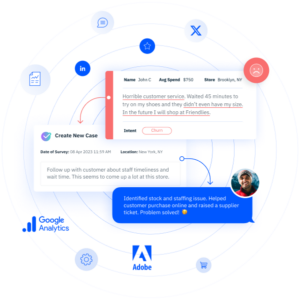5 Ways to Focus CEM on Actions Instead of Insights
“What is the one thing that can make the biggest difference to my customers today?”
This is a seemingly innocuous question, but one that can have far-reaching impact. For local managers this is likely a question they ask themselves every day. Their job is to motivate and guide their staff to deliver great branded experiences, and coach them on the little things to focus on to make the biggest impact for their customers.
Getting to the answer to that simple question however, is all too often anything but simple.
Running a location is an all consuming job. Location managers are asked to do many things. In both a figurative and literal sense they’re the ones tasked to keep the lights running on a day to day basis. As such their time is incredibly valuable; from dealing with logistics, to dealing with staff issues, locations managers have little time for tasks that fall outside their immediate duties. In many cases this means managing a customer experience program falls through the cracks.
Customer experience management programs have been used for many years as a mechanism to ensure operational efficiency. In many cases however the results of these programs have hit a standstill. One of the reasons for this is how these programs have evolved into rather complex data analysis programs. All too often programs require managers to focus on time consuming reporting, rather than helping them drive actions and develop new behaviors in their staff.
So how can these programs evolve to help local managers better focus on and understand what can be done each day to have the biggest impact on customers?
Some elements to consider when considering how to drive more action from a customer experience program are as follows:
Simple, clear information
Location managers need answers and focused directions, not more work. These busy professionals need tools to help surface only the information critical to them and to present it in a way that makes sense to them.
Select and align each location with specific top priorities
Location managers are not data analysts – they do not have the time or training to become one. Look for customer experience tools that provide algorithms to analyze the data and deliver insights so that they don’t have to. The right tools can provide specific focus areas and clear target objectives. This allows busy managers to focus their time on executing on priorities.
Action plans to execute behavior change
Knowing what area of the customer experience that needs to improve is just the beginning of a successful customer experience program. If the staff does not change their behavior then the customer experience will not improve. A location manager’s role in the customer experience program should be to coach and motivate the frontline staff to drive behavior change that will benefit the customer.They need the knowledge and the tools to execute this behavior change. The right tools should be able to present an action plan based on best practices for their specific focus areas.
Social sharing of best practices
Locations should be able to learn what actions have been successful in other locations with similar issues. Best practice libraries are living online resources that can adapt to the real world. Location managers (and their regional managers) can use these tools to contribute new actions and give feedback on which actions work well and which do not.
Status monitoring to track progress
Locations need an easy way to track their overall progress as well as the execution of specific staff behavior. In thirty seconds location focused tools should be able to tell a manager exactly what the staff is successfully executing on and not. This enables data-driven conversations based on real customer insights.
